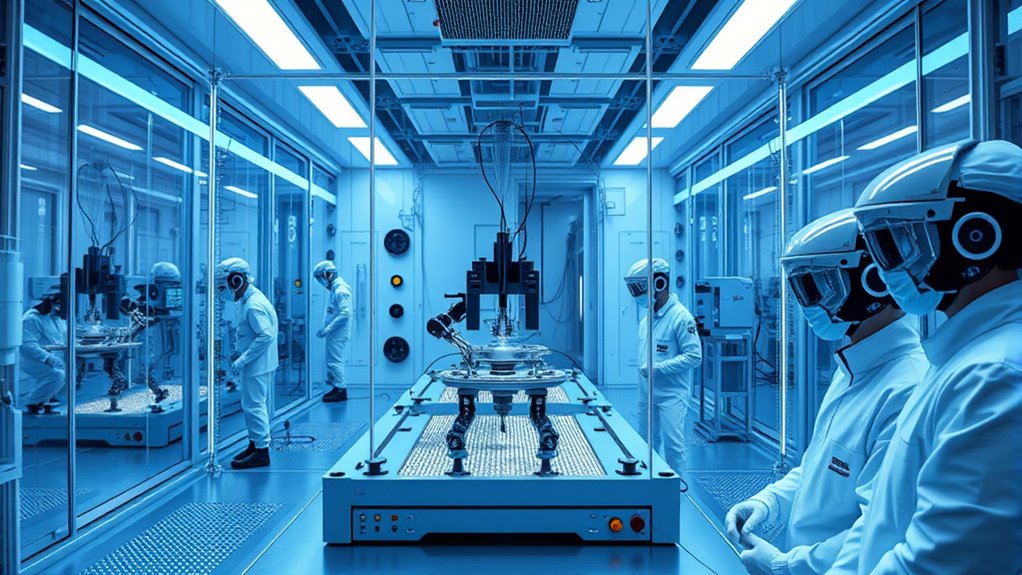To scale nanotech manufacturing safely, you should start with early risk assessments to pinpoint hazards and develop mitigation strategies. Optimize your processes for efficiency, control variations, and implement automation to maintain quality at larger volumes. Invest in specialized equipment and train staff thoroughly on safety protocols. Stay compliant with regulations and continuously monitor safety standards. Following these steps ensures a smooth, secure shift—if you keep exploring, you’ll discover even more ways to achieve safe, large-scale nanotech production.
Key Takeaways
- Conduct early comprehensive risk assessments to identify safety, environmental, and quality concerns before large-scale production.
- Develop and implement strict safety protocols and staff training to manage nanomaterial hazards effectively.
- Adapt small-scale synthesis techniques with process modifications to maintain nanostructure integrity during scale-up.
- Use automation and monitoring systems to ensure process consistency and detect anomalies at larger production volumes.
- Stay current with regulations and incorporate risk mitigation strategies to ensure compliance and facilitate safe manufacturing.

Have you ever wondered how nanotechnology can move from lab experiments to large-scale production? Transitioning from small-scale research to industrial manufacturing isn’t straightforward. It requires meticulous planning, especially around risk mitigation and process optimization. In scaling nanotech manufacturing, you need to identify potential hazards early on and develop strategies to prevent or minimize them. This process begins with a comprehensive risk assessment that evaluates safety concerns, environmental impacts, and quality control issues. By proactively addressing these risks, you can avoid costly setbacks and ensure the process remains safe and reliable as production scales up.
Scaling nanotech from lab to industry requires careful risk assessment and strategic planning to ensure safety and reliability.
Process optimization plays a central role in this transition. You need to refine each step to maximize efficiency while maintaining precision. Small variations that are negligible in lab settings can become significant at larger scales, so implementing robust controls is essential. Automation and advanced monitoring systems can help you maintain consistency, detect anomalies early, and reduce human error. Optimizing processes also involves adjusting parameters like temperature, pressure, and flow rates to suit larger volumes without compromising the nanomaterials’ properties. This ensures your products meet quality standards while reducing waste and energy consumption. Incorporating scalable synthesis methods is also crucial to ensure that production can meet increasing demand without sacrificing quality or safety.
Another critical aspect is developing scalable synthesis and fabrication methods. Techniques that work well on a small scale may not translate directly to industrial production. You’ll need to adapt or redesign processes to handle increased quantities while preserving nanostructure integrity and functional performance. This often involves investing in specialized equipment or modifying existing machinery for higher throughput. Collaboration with engineers and process specialists can accelerate this phase, helping you identify bottlenecks and implement improvements quickly.
Safety protocols must also evolve alongside process advancements. As production volumes grow, so do the potential risks related to handling nanomaterials, which can be hazardous if not managed properly. You should establish strict safety guidelines, including proper containment, ventilation, and waste disposal procedures. Training staff thoroughly ensures everyone understands the importance of safety measures, reducing exposure risks.
Finally, regulatory compliance becomes increasingly important as your manufacturing scales. Staying updated with industry standards and government regulations helps you avoid legal complications and fosters trust with customers and stakeholders. Incorporating risk mitigation strategies and process optimization early in your scaling plan ensures smoother transitions, minimizes setbacks, and sets the stage for sustainable growth. With careful planning and execution, you can bring your nanotech innovations from the lab to the market safely and efficiently.
Frequently Asked Questions
How Does Nanotech Manufacturing Impact Environmental Sustainability?
Nanotech manufacturing can positively impact environmental sustainability by reducing resource use and waste through increased resource efficiency. You might find that nanotech enables cleaner production processes, minimizing harmful emissions and pollutants. However, you should also consider potential environmental impacts, such as nanoparticle release or toxicity, which could pose risks. Overall, when managed properly, nanotech helps you achieve more sustainable manufacturing by balancing innovation with environmental responsibility.
What Are the Key Safety Protocols During Large-Scale Nanotech Production?
Imagine managing tiny worlds where a single nanoparticle could cause big trouble. You need strict safety protocols like robust nanoparticle containment systems to prevent accidental releases. Hazard mitigation strategies, such as proper ventilation and protective gear, are essential. Regular training keeps everyone alert, and continuous monitoring guarantees safety standards are upheld. By combining these measures, you protect both your team and the environment during large-scale nanotech production.
How Can Quality Control Be Maintained at Industrial Nanotech Scales?
You can maintain quality control at industrial nanotech scales by implementing rigorous quality assurance protocols and strict process standardization. Regular inspections, real-time monitoring, and validated procedures guarantee consistency and detect deviations early. Training your team thoroughly and leveraging automation helps uphold high standards. By continuously reviewing data and refining processes, you ensure reliable product quality, minimizing risks and maintaining safety throughout large-scale nanotech manufacturing.
What Are the Legal Considerations for Scaling Nanotech Products Globally?
When scaling nanotech products globally, you need to prioritize legal considerations like safeguarding your intellectual property rights and ensuring regulatory compliance across different countries. You should register patents, monitor international laws, and adapt your products to meet diverse safety standards. Staying informed about evolving regulations helps you avoid legal pitfalls, protect your innovations, and smoothly expand your nanotech manufacturing operations worldwide.
How Does Scaling Affect the Cost-Efficiency of Nanotech Manufacturing?
Like a ripple spreading across a pond, scaling your nanotech manufacturing boosts economies of scale, which drives cost reduction. As you increase production, fixed costs are distributed over more units, making each one cheaper. This enhances efficiency and profitability. However, be mindful that rapid scaling can introduce complexities, potentially offsetting gains. Careful planning guarantees you harness the full benefits of scaling without compromising quality or safety.
Conclusion
As you scale nanotech manufacturing, remember that the industry is projected to reach a $125 billion market by 2030. This rapid growth highlights the immense potential, but also underscores the importance of safety. By implementing robust protocols now, you’ll help prevent accidents and guarantee responsible innovation. Embrace the challenge, stay vigilant, and you’ll be at the forefront of this groundbreaking technology—making a real difference while shaping the future.









